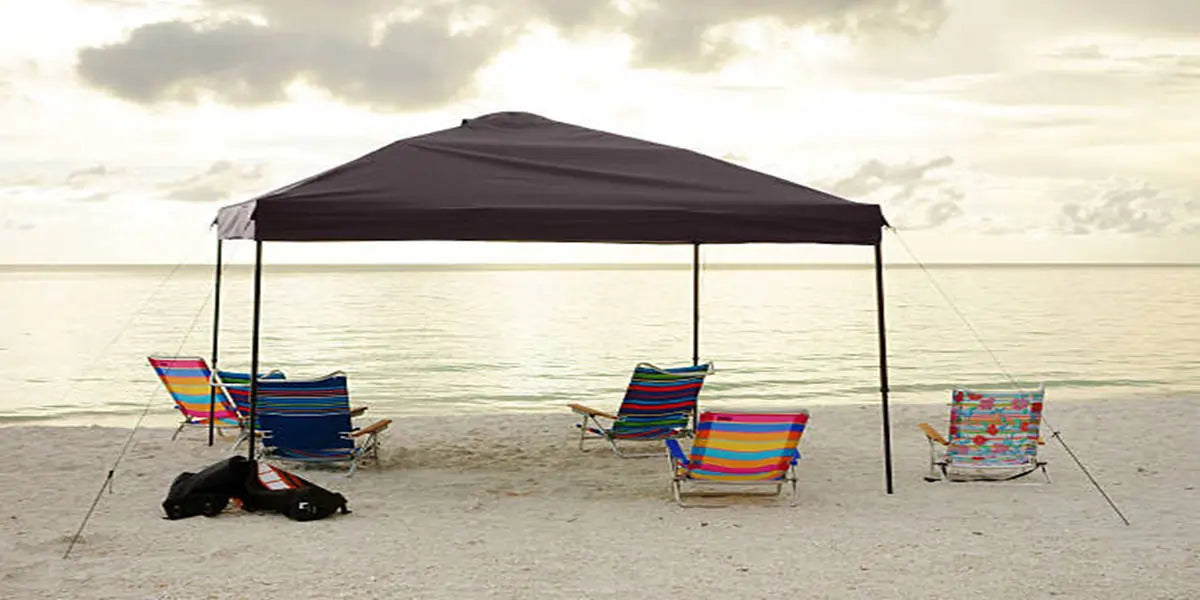A canopy tent is great outdoor equipment to have. It is suitable for a variety of places. Whether it's at a farmers' market or trade show for commercial use. Or in camping, party use is a must-have existence.No matter which purpose you use it for, a canopy tent can be your best partner in the outdoors.
First of all, it can be waterproof and UV-proof, which can keep you protected in different weather conditions. Secondly, the pop-up canopy has a simple frame and takes less time to install. But it is the convenience of the frame that leads to the very limited level of wind that a canopy tent can withstand. General breeze is certainly no problem. But if you need to use it in the windy season, you have to consider what ways to prevent the canopy from being blown away. To help solve our guests' questions, you can refer to the following ways.

What level of wind canopy tent can withstand
Of course, different materials of the tent frame will have different wind resistance. Quictent's pop-up canopy is used a reinforced powder-coated steel frame, very durable. In the case of not using any reinforcement, measures can withstand at least 20 MPH of wind. This is already more than the breeze range. The reinforced pop-up canopy can withstand up to 40 MPH of wind. What you need to know is that 40 MPH is already a high wind level, and most tents cannot withstand winds over 40 MPH. Especially for canopy tents that belong to outdoor shelters, 10-30 MPH is the range that most canopy tents can withstand.
Ways to prevent canopy tent from blown away
Find the right frame
It's not just the material of the frame, but also the construction and weight. If you want a canopy tent that can withstand more wind, then you need to choose full truss construction. This construction of the frame will make the whole tent more solid, and there are more brackets for you to hang string lights and other decorations. The material of the joints of the frame is also important, plastic joints will easily be blown apart by the wind. At the same time, in pursuit of easy-to-carry, pop-up canopy weight is generally lighter. Of course, the more heavy-duty frame will meet your needs.

Suitable location
Before setting up the tent, level ground is the best choice. This is not only more stable but will also make it easier for you to find a suitable location for reinforcement. And what type of ground prompts different ways of reinforcement? For example, grass and concrete are the high-frequency used in canopy tents. These two types of ground reinforcement are the opposite.
Use of stakes and ropes
This type of reinforcement can be done in two ways, using stakes or anchors alone and using anchors and ropes together. The first way is to insert the stake or anchor into the hole at the foot of the canopy tent frame to enhance stability. The second way is to insert the anchor into the leg of the frame at a distance from the frame. After that, the middle of the frame is connected to the anchor with a rope to form a 45-degree tilt angle.

During the insertion of the anchor or stake, it is best to use a hammer to drive it as deep into the ground as possible to ensure that stability is maintained. If the wind gradually becomes stronger, then you will need to increase the number of stakes. It is better to drive another stake at the back and use a spare wind rope to apply a force in the opposite direction to the stake in front, it will be more stable. This method should only be used on soft ground, such as grass or sand.
Using sandbags
The use of sandbags to add weight is also a common practice. Tying sandbags to the legs of the frame will add extra stability to the tent. Quictent's section of the pop-up canopy will give you sandbags for free. For example, a 10x20 pop-up tent will provide 4 sandbags, and each sandbag weighs 22 lbs. This is the best choice for reinforcing the canopy tent on concrete.

Try different methods to add weight
For a canopy tent set up on a concrete floor, adding weight to the bottom of the frame is the best way to reinforce it. So, you can also try to use other things besides sandbags. As written in the previous article about pop-up gazebo tents, using a bucket filled with water is an affordable and convenient way. In addition to this, multiple bricks, rocks, and other things that can add weight can be used.
Take off the sidewall
Windy weather is not suitable for the presence of sidewalls. In other weather conditions, the sidewall is a great accessory. It keeps warmth in winter and keeps out rain. The rest of the year it adds privacy. But when it's windy, the sidewall is like a liability to you. Once the wind blows through, it will collapse with the whole tent.

Final Thoughts
Although we have described many ways that allow you to reinforce your tent on windy days. But the pop-up canopy itself is not made for extreme weather. The best time to use it is in calm weather, where light rain and breezes don't hurt. However, if it is already over 40 MPH, it is recommended that you take down the canopy tent to avoid damage to it.








